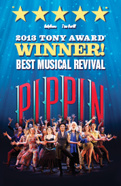Pippin Circus Creator Gypsy Snider Shares the Moving Story of How Growing Up Under the Big Top Prepared Her for Life
About the author:
In the Tony-winning revival of Pippin, acrobats flip and fly through the air thanks to Gypsy Snider, the production's resident circus creator. Pippin marks Snider's first foray onto the Great White Way, but her career as a performer began at age four. After cutting her teeth in San Francisco at her parents’ Pickle Family Circus, she toured internationally with Cirque du Soleil and co-founded the acrobatic troupe Les 7 Dogts de la Main, a Montreal-based company responsible for the hit show Traces. Below, Snider recalls how her unusual upbringing prepared her for a host of life’s challenges, and how a sushi lunch convinced her to bring a taste of the circus to Broadway in Pippin.
![]()
As a child, I performed in the Pickle Family Circus—the first alternative circus in the United States—alongside my mother and stepfather, the co-founders. My parents weren’t just people who made my lunches and told me to do my homework. I learned from them every day by watching them work and working with them. Most importantly, they taught me that no matter how bad you feel or how hard life can be, the show must go on. It was a very profound lesson for me, and it’s become a wonderful parallel for my own life.
The circus has always been my life, but everything turned upside-down in January 2008: I was diagnosed with advanced stage colon cancer. I needed massive abdominal surgery and rounds of chemotherapy and radiation—suddenly, my work felt trivial and my family became more important than ever before. I began to question how taxing show business can be and wondered if I should just move to the country and raise my two daughters in a stress-free environment, instead of in the glory of this wonderful but all consuming lifestyle. It was during this difficult time that Diane Paulus reached out to me about the possibility of collaborating on a new production of Pippin.
My first meeting with Diane was at a sushi restaurant in Montreal. Aside from a Google search, I didn’t know her background, and I had never seen Pippin before. But after reading the script and doing some research, I realized I was familiar with certain pieces, like Ben Vereen and the Manson Trio, and songs like “No Time at All.” I think the fact that I never saw the full package was vital in creating this reimagined revival. I saw Pippin with pure eyes. I knew that Diane wanted the company to become a circus troupe, and so that was my only vision of the story.
As Diane and I talked, we realized how much we had in common: We both have two daughters, and as women in our 40s, we really connected. Right away, we started having philosophical conversations about Pippin and the circus. Right now, in American pop culture, there’s this aggressive desire to be extraordinary, almost to the point of violence. I think this was also something that was true after the Vietnam War, when Stephen Schwartz wrote this piece. I was fascinated to hear that Diane felt the same way on many of the important levels of Pippin—it was a wonderful creative match.
My cancer officially went into remission during tech rehearsals of Pippin at ART in Cambridge. But as the production approached Broadway, I began to worry. It was so difficult not to be able to have my children with me. I could fly home on the weekends, but I was torn. What if the cancer comes back? What are the things that I truly want? I have always wanted my children to be proud of me. I believed in Pippin from day one, and I couldn’t have walked away from it for the world.
With Pippin, I was in love: I hired some of the best acrobats in the world, who are not only excellent at what they do, but are incredibly expressive and theatrical and passionate people onstage. They’re not just performing tricks, they’re also beautiful to watch. But what really blew my mind was that the dancers and the actors all wanted to be a part of the circus world, too. The passion that Patina Miller, Matthew James Thomas, Andrea Martin, Terrence Mann and Charlotte d'Amboise have has surpassed anything that Diane, choreographer Chet Walker and I could have ever dreamed of. I’m not used to working with non-circus people, and it was so enriching to have to rethink my whole creative process.
Working with Andrea, for instance—finding the right thing for her to do took months. But during rehearsals, she was so persistent, and I thought, “This woman is insatiable!" She told me we needed to show that the character of Berthe embodies the meaning of her song “Just No Time at All”: This is a woman who lives life to the fullest. It has to evoke the dangers of the circus, but it has to be safe. I kept racking my brain, and finally I realized she could do a pas de deux on the trapeze with Yannick Thomas. It would show her incredible strength, but because he would essentially be holding her, it would also show her fragility.
In the circus, it’s wonderful when you get the chance to perform a trick that’s seamless and perfect. The audience loves it! But when you miss a trick and you have to get up and do it over again, the audience has more of a vested interest; they understand the risk. They want to see you brush yourself off and try again and again until you nail it. This lesson can become a gift to the audience: No matter how hard things become, there is no failure. It’s the message I continue to live by.
